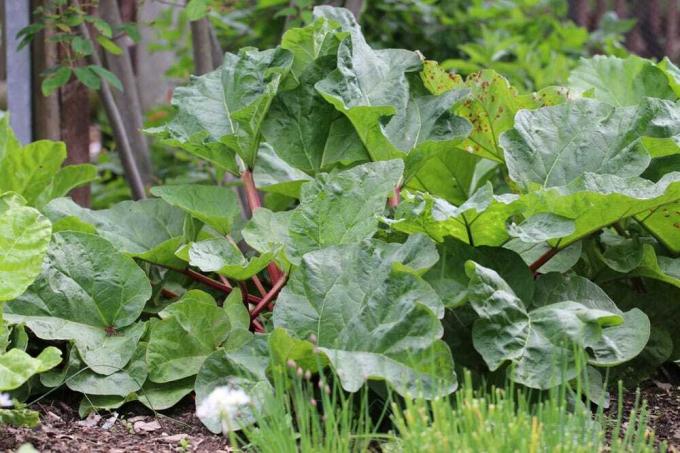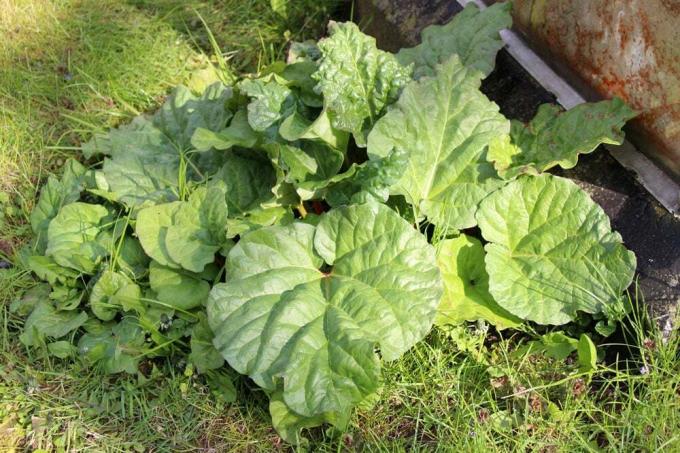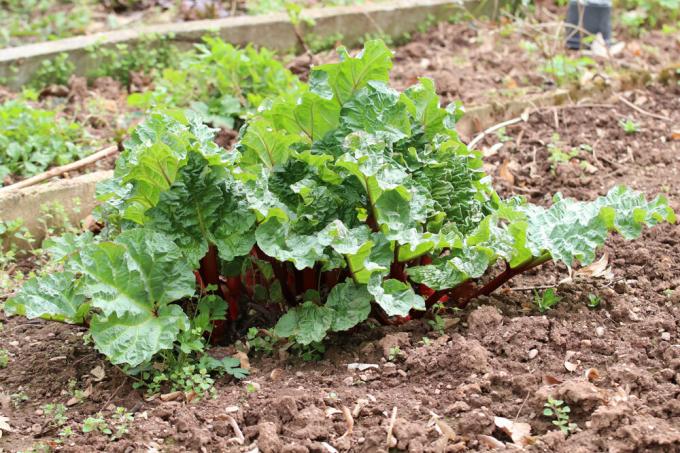

Table of contents
- root depth
- Dig out
- Distance
- width and loosening
- depth
- Prepare planting hole
If a rhubarb is in one place for several years, the substrate is used up. This leads to weaker growth and lower yields. In addition, the plant becomes more susceptible to diseases and pests. Even regular fertilization cannot compensate for the consumption of the heavy feeder. When transplanting, however, the root depth of the Rheum rhabarbarum must be taken into account.
root depth
Rhubarb flowers can reach a height of up to two meters. The older the plant is and the longer it is in one place, the taller the inflorescence will be. Provided that the conditions at the location are optimal and the crop is sufficiently supplied with nutrients.
But what does that have to do with the root depth of rhubarb?
The height of the flowers is a good indication of how deep the plant's roots reach. Because these also gain in depth and spread the longer the plant is in the same location. Depending on the composition of the soil and the age of the plant, depths of up to around two meters are possible. This also explains why rhubarb is proving to be a stubborn plant.
Dig out
As a heavy feeder, rhubarb develops comparatively deep roots. On the one hand, this makes the plant very robust and resilient. On the other hand, it ensures the supply of nutrients and liquids and makes the Rheum rhabarbarum an easy-care plant. Despite these advantages and the low effort required to cultivate rhubarb, it requires large amounts of nutrients.

After about ten years at the same location, the substrate is therefore used up. Even regular fertilization and the supply of nutrients through the plant parts of the rhubarb are then no longer sufficient to provide the plant with comprehensive care. A change of location or the addition of fresh substrate must take place in order to continue to ensure a good yield. For this, however, it is necessary to know how deep and broad the roots of the rhubarb are.
Therefore, when digging, attention should be paid to the following factors:
Distance
The distance to the plant should be 30 to 50 centimeters. Ideally, the first sod should be cut half a meter from the plant.
width and loosening
Due to the diameter of one meter, digging up the plant is comparatively complex. By loosening the soil, the substrate and thus the weight can be removed in a gentle manner. Care should be taken to ensure that only thin layers of soil are loosened and removed with a rake. Otherwise, the roots could be injured.
depth
As a rule of thumb, two and a half spade lengths should be excavated. A depth of 70 to 80 centimeters is even better. This depth preserves most of the roots and allows the plant to regenerate quickly and sprout new roots with ease.
Tip:
After digging up the rhubarb, the severed root ends should be allowed to air dry for a few hours. This reduces the risk of mold and rot forming.
Prepare planting hole

Whether the rhubarb is moved to a new location or the substrate is simply renewed - in any case, the planting hole should be prepared accordingly. Just like when digging up the Rheum rhabarbarum, there are a few points to consider. These are:
1. Step
Depth and circumference: In order to give the plant enough space, the planting hole must be at least 70 centimeters deep and should have a diameter of 60 to 100 centimeters. A total of one square meter of space should be available for the rhubarb. This is already necessary due to the length and dimensions of rods and blades.
2. Step
Fresh substrate and organic fertilizers contribute significantly to the nutrient supply and the health of the crop. Fresh soil enriched with compost should therefore cover the bottom of the planting hole. After moistening the fresh substrate and inserting the plant, the entire planting hole should be filled with it.
3. Step
The earth should be filled in in narrow layers and compacted again and again. In this way, the roots are protected and the plant is given support. Plant parts and leftovers of rhubarb can also be worked into the upper layers. These serve as an organic long-term fertilizer.
The effort involved in moving the rhubarb may seem great at first, but it is only necessary every seven to ten years. The better the plant is fertilized and the soil is cared for, the less often it is necessary to transplant.
 Home editorial office
Home editorial office
Learn more about rhubarb

When and with what to fertilize rhubarb?
Properly prepared, rhubarb is a real treat. However, in order to thrive, it needs sufficient nutrients. The right fertilizer plays an important role in this.

Rhubarb location: 4 important criteria
Rhubarb, which is related to sorrel, is a fruity, sour stem vegetable that can be harvested from around April. It is hardy, extremely easy to care for and needs a new location every few years. The harvest season traditionally ends on St. John's Day, the 24th. June.

Pruning rhubarb after harvest - how is it pruned?
Rhubarb - which is actually a vegetable - is a popular topping for cakes and tasty as a compote. As a garden plant, however, it poses many a puzzle. This includes the cut. Interested parties can find out when it makes sense and when not.

Transplanting rhubarb | the best time to plant | planting time
Fruity, juicy and full of vitamins - if you plant rhubarb in your garden, you always have an aromatic vegetable at hand for summer desserts or cakes. But when cultivating the popular vegetable, it should be borne in mind that the delicious sticks need to be moved from time to time in order to produce a rich harvest.

Cooking rhubarb jam - basic recipe
Rhubarb, a wonderfully old-fashioned vegetable, is back in fashion, at least in the kitchen. There are now different breeds with green or red flesh and they grow almost by themselves in the garden. Until the 24th It should be harvested and processed by June. The classic is rhubarb jam, and with good reason.

Harvest rhubarb - this is the best harvest time
Rhubarb is a fascinating vegetable that enjoys great popularity and can be found in many private gardens. No wonder: it tastes good, can be used in many ways in the kitchen and is relatively easy to grow. The crux of the matter is usually the harvest and the question of when the harvest can take place. Here are the answers.
